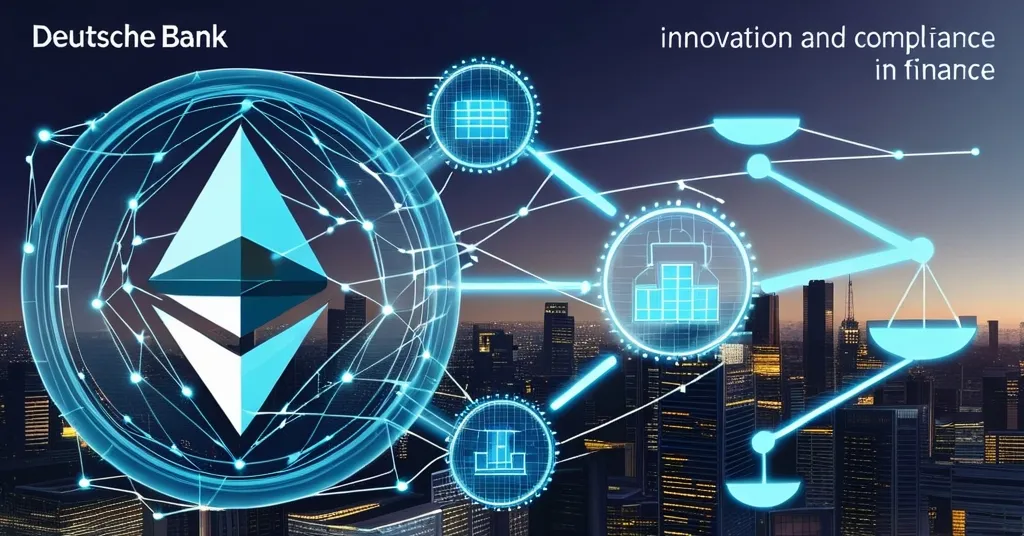Deutsche Bank Partners with ZKsync for Ethereum Layer 2 Blockchain Advancement

Deutsche Bank Enters the Ethereum Blockchain Space with ZKsync
Deutsche Bank, Germany’s leading financial institution, is embarking on a transformative journey in blockchain technology. By developing a Layer 2 solution on the Ethereum network with ZKsync technology, the bank aims to address complex regulatory challenges while enhancing transaction efficiency. This development forms a part of Project Dama 2, which is closely aligned with Singapore’s Project Guardian, focusing on secure blockchain deployment within regulatory frameworks.
- Developing Ethereum Layer 2 using ZKsync to tackle regulatory issues.
- Project Dama 2 collaborates with Singapore’s Project Guardian.
- Introducing “super admin rights” for regulatory monitoring.
- Test version launched in November, with a minimum viable product planned for next year.
- Partnership with Crypto.com to extend services in Asia-Pacific.
Understanding Ethereum Layer 2 and ZKsync
Layer 2 solutions on Ethereum, such as the one Deutsche Bank is developing, are crucial for scaling blockchain applications. They aim to offload transactions from the main Ethereum chain (Layer 1) to increase speed and reduce costs. ZKsync, the technology employed here, uses zero-knowledge proofs to ensure privacy and efficiency, allowing transactions to be validated with minimal data, thus preserving the confidentiality and integrity of financial records.
Project Dama 2 and Regulatory Compliance
Project Dama 2 is designed to integrate blockchain technology into traditional banking systems while maintaining compliance with regulatory standards. According to Boon-Hiong Chan, Head of APAC Securities Market and Technology Advocacy at Deutsche Bank, the dual-chain approach is pivotal in satisfying regulatory requirements. Chan remarked, “Using two chains, a number of these regulatory concerns should be able to be satisfied.” This layered architecture could reduce the dependency on Ethereum’s primary chain for transaction details, as noted by Chan, “You are not dependent on the Layer 1 for detailed transaction records anymore.”
The project includes a unique feature granting regulators “super admin rights” for oversight, aligning with global standards for transparency and control. This capability could significantly mitigate regulatory risks, making blockchain integration more palatable for financial institutions.
Milestones and Partnerships
Last November marked the release of a test version of their blockchain solution, signaling progress towards a minimum viable product in the coming year, subject to regulatory approval. Deutsche Bank is pursuing these targets with the aid of partners like Memento Blockchain and Interop Labs, who bring technical expertise to the project.
Further cementing its commitment to blockchain, Deutsche Bank has partnered with Crypto.com to advance its corporate banking offerings in the Asia-Pacific region. This alliance could expedite the adoption of blockchain in corporate finance, leveraging Crypto.com’s established infrastructure and expertise in digital assets.
Implications and Future Prospects
With global financial institutions exploring blockchain’s potential, Deutsche Bank’s Project Dama 2 represents a significant step towards integrating blockchain into mainstream banking, while ensuring regulatory compliance. The collaboration with Singapore’s Project Guardian exemplifies the necessary balance between innovation and regulation in the financial sector.
However, questions remain about the scalability and adaptability of such solutions in diverse regulatory environments worldwide. How will Deutsche Bank’s approach influence global financial regulations? Could this partnership with Crypto.com be a catalyst for wider blockchain adoption in banking? These strategic moves by Deutsche Bank are likely to inspire further collaborations and innovation across the industry, as other institutions watch closely to see how these developments unfold.



